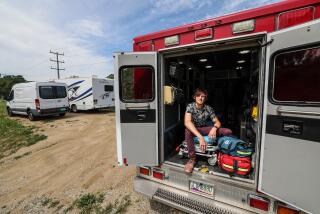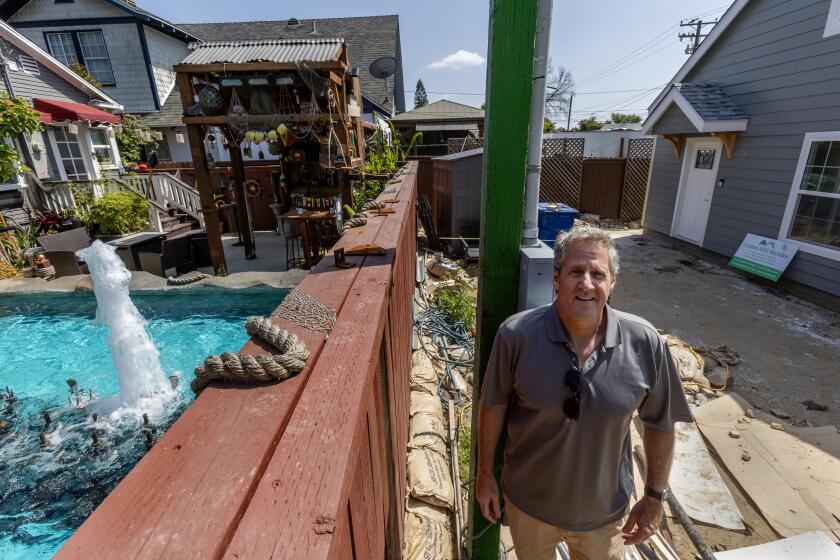Stunt fliers filled the skies over Venice
In the early 1920s, long before it became famous for roller-skating, Venice was the capital of another sport: stunt flying.
It was a time, as author Don Dwiggins put it, when barnstormers and carnival fliers gathered at DeLay Airfield “to try out new ways to cheat death for money.”
When a daredevil thought of a new maneuver that the movies or newsreels might buy, he’d drop out of the continuous poker game in the DeLay hangar to give it a try (hoping he’d live to be dealt another hand).
So many wing-walkers inhabited the skies that Venice, which was then an independent city, passed an ordinance prohibiting low flying over churches on Sundays.
The airfield was run by, and named for, pilot B.H. DeLay, a two-fisted chap as colorful as any movie character.
DeLay performed in more than 50 films and claimed several innovations, including the first jump from an airplane onto a moving train.
With “a passionately driven nature derived from his French American heritage,” as his great-granddaughter Shawna Kelly described him, the handsome pilot also engaged in several extramarital affairs.
On one occasion, he faced down a gun drawn by his angry wife, said Kelly, author of “Images of America; Aviators in Early Hollywood.”
“It was the roaring ‘20s,” she noted. “People were wild.”
That included wild about seeing aerial stunts. DeLay charged $40 an hour for staging wing walks, $100 an hour for making leaps onto or off of aircraft and $350 a week for movie work.
But his brief career came to an end July 4, 1923, when he attempted to “loop the loop” at 2,000 feet over Ocean Park.
His wings “bent back as though on hinges,” the Los Angeles Examiner reported, and the plane plummeted to the ground, killing DeLay, 31, and his passenger, a businessman friend.
It happened before the horrified faces of “thousands of motorists and pedestrians, celebrating the Fourth at the beaches, (who had) paused to watch the airship’s movement,” the Examiner said.
Of course, death was not an uncommon fate for stunt pilots. DeLay himself had survived several other unscripted crashes, including one on a night flight.
The L.A. County Coroner’s office ruled the death an accident.
But author Kelly believes it was a case of sabotage, which is one of the reasons she wrote the book.
She points out that the Los Angeles Evening Express raised the possibility afterward of “an aerial murder.”
She thinks the incident might have been related to a ruckus that broke out several days earlier at the airfield between DeLay and a businessman. Each claimed to own the property, located near the corner of Venice and Abbott Kinney boulevards.
DeLay had also told people that someone had fired a gun at him one recent night while he walked near Clover Field (now Santa Monica Airport).
After DeLay’s crash, there were rumors that a saboteur had inserted smaller than normal pins to support the wings of his plane. The problem with the subsequent investigation, Kelly says, is that the plane was so obliterated by the crash that “there wasn’t much evidence left.”
But the Los Angeles Evening Herald had a different take on the incident. The newspaper said that “local flyers … attributed the accident to DeLay’s fondness for daring stunts and … declared he was extremely careless in the upkeep of his airplanes.” In addition, the Los Angeles Times reported that the plane, which was custom-made for DeLay, was built “for straight flying and not for stunts.”
Whatever the truth, Kelly says, she also wrote her book for another reason — as an appreciation for brave people like her great-grandfather and “the other motion picture aviators who risked their lives like no other actors.”
Frank Clarke, for instance, flew his Jenny off a 10-story building in downtown Los Angeles during the filming of the movie “Stranger Than Fiction.”
The aircraft had been disassembled and secretly hauled to the top of the building first. When it was time for him to leave, Kelly writes, “Clarke roared off from the short hundred-foot long roof … dipped several stories … (then) swooshed up just in the nick of time.” He was arrested but talked his way out of a ticket. He died in a plane crash several years later at the age of 49.
Another daredevil was Ormer Locklear, who crashed and died at 28 during the making of “Skywayman.” Locklear, reputed to be the first wing-walker, had been making a night maneuver when he was blinded by lights that were supposed to be turned off.
Ironically, one stunt pilot who lived a full life was Dick Grace, who specialized in crashing planes in the movies.
A friend of DeLay, Grace was a writer on the 1932 film “Lost Squadron,” whose plot involved a sabotaged plane.
By then, the hangar at DeLay Airfield had been leveled and the property converted into a real estate development. And the stunt fliers had left Venice and moved on to airstrips in other communities, taking their poker game with them.
More to Read
Start your day right
Sign up for Essential California for news, features and recommendations from the L.A. Times and beyond in your inbox six days a week.
You may occasionally receive promotional content from the Los Angeles Times.






